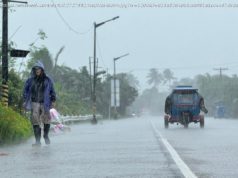Puerto Rico’s shrinking population has been a cause for concern, but now catastrophic hurricane damage could force even another exodus.
Financially troubled Puerto Rico’s shrinking population has long been a cause for concern, but now the catastrophic damage and slow recovery from Hurricane Maria could force even more people to flee, making its economic outlook and recovery that much more shaky.
A week after the category 4 storm, the recovery has been painfully slow and the devastation is worse than expected. The prospect of months without electricity across the island, the lack of potable water and thousands of homeless people make some amount of migration to the mainland from the U. S. territory all but guaranteed.
Politicians in New York and Florida, two states likely to draw many Puerto Rican residents because of community and family ties, have been among the first to respond with aid and other support.
The Miami-Dade school district, for instance, has said it is prepared to take in students from Puerto Rico and expects to see an influx once flights return to normal from the island.
« We have already over 2,000 Puerto Rican-born children, who are students in our school system. The family connections between Miami Dade and the island are very strong, » said Alberto Carvalho, Superintendent of Schools for Miami Dade. « We are obviously expecting to receive a significant number, in the hundreds, to at least a couple thousand. »
Carvalho said a dozen students arrived from Puerto Rico even before commercial flights resumed. He expects more to trickle in, with the first most likely to be individuals with financial wherewithal, coming as families or sending their children to stay with relatives.
The next wave he expects will be those that are less financially well off, and they could come in greater numbers as has happened in other crises where Florida was a destination for residents from Caribbean or Latin America nations. The fact that Puerto Ricans are Americans enables those leaving the island to easily enter and stay on the mainland.
Puerto Rico’s dire circumstances are compounded by the commonwealth’s bankruptcy. It has seen its revenue flows cut short by its inability to provide even basic services for its 3.4 million residents. It has also lost the flow of tourist money, and it’s difficult to say when that industry will recover.
The progress has been slow with containers filled with supplies stuck at the port, and fuel shortages are aggravating the movement of goods.
Gov. Ricardo Rossello warned several days ago that without more U. S. aid, the territory risks a mass migration that would impair its ability to recover. « Massive migration » he was quoted saying, « would deteriorate our [economic] base here in Puerto Rico and would provoke significant demographic shifting in other areas of the United States. »
Rossello asked for an aid package just like a U. S. state would receive. Rossello told CNBC Thursday that food and water are still needed urgently needed. He said he’s seeking lines of credit at « reasonable rates » from the Federal Reserve and the Treasury for rebuilding.
In making federal hurricane aid requests, Rossello said on » Squawk Box » he has yet to get a commitment for new loans to help with the cost of the massive cleanup and eventual rebuilding. He said Puerto Rico expects « equal treatment » to hurricane-stricken Florida and Texas when it comes to allocating relief resources.
On Thursday, House Democrats called on Speaker Paul Ryan to push forward legislation right away. Ryan, in a briefing with reporters, said there was $6.7 billion already approved for hurricane relief that will be released within two days, and Puerto Rico will receive some if it.
Ryan said the Trump administration will do an assessment of damage and seek more funds from Congress for Puerto Rico, probably in October. Providing aid to Puerto Rico has been much more difficult than it was for Texas and Florida when they were hit by hurricanes because it is an island, he said.
President Donald Trump, who said the U. S. is responding well to the crisis, is expected to visit Puerto Rico on October 3. On Thursday, the Trump administration waved a maritime rule, the Jones Act, allowing foreign flagged carriers easier access to San Juan with shipments of medicine, food and water, but CNBC reports that there is already a back up of goods waiting to be distributed.
Puerto Rico is currently focused on funding the return of basic services.
But ultimately, the Puerto Rican oversight board will have to focus on the territory’s longer-term financial plan. That will have to include the consideration of changing revenue, and a potential change in population if there is a significant migration, according to Curtis Erickson, head of capital markets at Preston Hollow Capital.
« It’s going to be a long rebuild. It’s a lot of devastation. When you’re looking at a three to five year rebuild, people might make the decision to have to live elsewhere, » he said.
Erickson said the oversight board will have to be a lot less optimistic.
« They’re going to make a decision that they have to allow for more variability in the budget and ultimately be more conservative, and more conservative might lead to shrinking the top line and ultimately asking bond holders for more reduction in debt, » he said.
Puerto Rico has total debt of about $74 billion, and most obligations are already in default. Projections for revenue to cover those debts are now shakier.
« As difficult as it was three months or four months ago to predict what future revenues were across the Commonwealth, it’s even more difficult now, » said Dennis Pidherny, managing director, U. S. Public Finance at Fitch Ratings. « We saw it after Katrina. There was a permanent decrease in population throughout the New Orleans area. We expect you very well could see that same type of fundamental shift in population, and it’s quite honestly anyone’s guess what the ‘new normal will be from an economic stand point for Puerto Rico. »
Pidherny said the math is simple when looking at the debt versus the population base that can pay for it, and a large outward migration would make a difference.
« The folks that were leaving before the hurricane were in fact the ones who had transferrable employment skills who could find jobs in the U. S., or there was a higher proportion of those folks that were atrracted to the U. S. because they wanted to work or could work as opposed to folks that were retiring or moving on to the later stages of life, » said Pidherny.
Puerto Rico’s fiscal plan from March 2017 shows forecasts for a 0.2 percent population decline a year. The Puerto Rican Department of Economic Development, prior to the storm, had a base case forecast of 3.16 million residents by 2025.
Pidherny said the factors that were considered cornerstones in a debt restructuring before the storm were the territory’s ability to stem or reverse migration; its ability to build and restore sustainable economic growth, and its corporations building more resilient and efficient infrastructure.
Home
United States
USA — Events Puerto Rico's new worry is a population flight to the US mainland...






